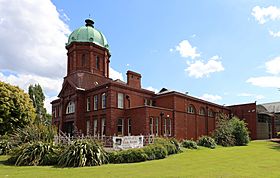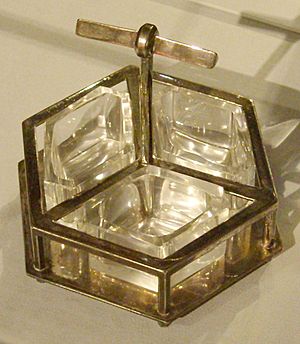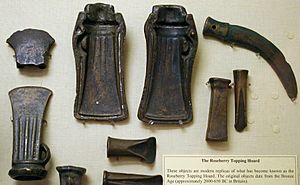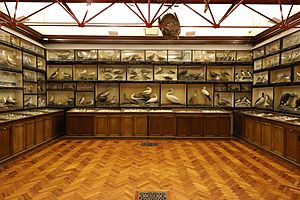Dorman Museum facts for kids

Dorman Museum
|
|
| Established | 1 July 1904 |
|---|---|
| Location | Linthorpe Road, Middlesbrough |
| Nearest car park | Street parking adjacent to museum |
The Dorman Museum is a cool place to explore local history and nature. It's located in Middlesbrough, North Yorkshire, England, right next to Albert Park. This museum is one of two run by the local council. As of August 2025, the museum has been closed for renovations, getting ready for future visitors.
The museum was started by Sir Arthur Dorman. He was a very important person from the Dorman Long engineering company. He built the museum to honor his son, George Lockwood Dorman, who sadly passed away during the Second Boer War.
When it first opened on July 1, 1904, the Dorman Museum was all about natural sciences. This meant it had lots of exhibits on animals, plants, and the natural world. Over time, the museum added new sections. These new parts focused on local art, like the Linthorpe Art Pottery, and the history of Middlesbrough itself. You can still see some of the original collections, like old stuffed animals, in the Nelson Room.
Contents
- Exploring the Museum's Collections
- Original Wonders of the Museum
- Art and Design: Christopher Dresser and Linthorpe Pottery
- Other Cool Things to See
- Frank Elgee's Discoveries
- Plants and Nature: Botanical Collections
- Ancient Tools: Bronze Implements
- Money and Medals: Coins and Medals
- Fashion Through Time: Costumes and Textiles
- Beautiful Objects: Decorative Arts
- Rocks and Fossils: Geological Collection
- Old Photos: Photographs
- Everyday Life: Social History
- Cultures from Around the World: World Cultures
- Animals and Insects: Zoological Collection
- Old Papers and Records: Archive and Ephemera
- Permanent Display Galleries
Exploring the Museum's Collections
The Dorman Museum has eight main display areas that are always there. It also has special temporary exhibits on the ground floor that change often. You can get to the upper floor using the main staircase or a lift. There's even a Victorian-style tearoom on the ground floor called Dresser's Tea Room, perfect for a snack!
Original Wonders of the Museum
The museum's first collections were full of amazing things. Imagine seeing a stuffed eagle owl catching a hare, or a lion standing tall! There were also many birds' eggs, butterflies, and insects kept safely under glass. One really unique item was a model of a human head louse, made to look 100 times bigger than real life! The museum also had a fossil of an ichthyosaur, which was a giant sea reptile from long ago. You could even see a long, thin ribbonfish, several meters in length.
One of the first people to give items to the museum was Henry Bolckow. He helped start Middlesbrough's biggest ironworks, Bolckow Vaughan. In 1874, he paid for some of the stuffed birds that became part of the museum's collection.
Art and Design: Christopher Dresser and Linthorpe Pottery
Christopher Dresser was a very important designer from the Victorian era. He played a big part in the Aesthetic Movement, which was all about making beautiful things. He was also closely involved with the Linthorpe Art Pottery, which was located very close to the museum. Because of this, the Dorman Museum has the best collection of Dresser's work.
A special grant helped to update this gallery in 2014. It shows off 160 pieces made directly from Dresser's designs. You can also see items made by other artists who were inspired by his style. Most of this collection was bought from one person, with help from the Art Fund and the V&A. The Linthorpe Art Pottery gallery tells the story of how successful this pottery was and where its ideas came from.
The museum also offers fun educational programs and activities based on these exciting collections.
Other Cool Things to See
The Dorman Museum has many different types of collections. Here are some of them:
Frank Elgee's Discoveries
The museum keeps a special library of notes and photos from Frank Elgee. He was a curator at the museum from 1923 to 1932. He explored ancient sites, like the Bronze Age hillfort at Eston Nab and burial grounds at Loose Howe. You can also see a very old dug-out canoe that was found in the River Tees in 1926. There's a green plaque at the museum entrance honoring Frank Elgee.
Plants and Nature: Botanical Collections
The museum has a large collection of dried plants, called a herbarium.
- It includes plants collected by Margaret Stovin between 1798 and 1850.
- There are also other plant collections from different people.
Ancient Tools: Bronze Implements
You can see copies of ancient bronze items found at Roseberry Topping. These include bronze axe heads, spearheads, and even a mold used to make more axes!
Money and Medals: Coins and Medals
The museum has about 1,900 items, including old coins, special medallions, badges, and banknotes. There are also military medals. Some famous collections include coins from the 16th and 17th centuries found in Yearby, and silver pennies from the time of King Henry II and Henry III found in Thorpe Thewles.
Fashion Through Time: Costumes and Textiles
There are 2,400 items of women's fashion from the 20th century, including shoes, hats, and accessories. The museum also has a smaller collection of uniforms, children's clothes, sportswear, and men's suits.
Beautiful Objects: Decorative Arts
This collection has 340 items, mostly pottery from the Middlesbrough Pottery. There are also pieces from other local potteries and glass makers. You can also see some 19th-century Japanese figures called okimono, which might be carved from walrus ivory.
Rocks and Fossils: Geological Collection
The museum has a collection of fossils, rocks, and minerals that show the history of the Earth.
Old Photos: Photographs
This collection has about 3,500 old photos, glass negatives, and carte de visite (small old photographs). There are also 2,190 lantern slides, which were used to project images.
Everyday Life: Social History
The museum has about 16,000 everyday objects from the 1930s to the 1980s. The museum started collecting these items because society was changing fast, and old ways of life were disappearing.
Cultures from Around the World: World Cultures
The museum has about 1,500 items from different cultures around the world. Some of these were collected by Sir Alfred Pease, including beadwork from North-East Africa. George Lockwood Dorman, who the museum is named after, also collected items from Australia, New Zealand, and South Africa during his travels. These items were a very important part of the museum's first collections.
Animals and Insects: Zoological Collection
This is the biggest part of the museum's collection, with over 150,000 specimens! Most of these are invertebrates, like molluscs (snails, shells) and insects. A popular exhibit used to be a beehive in a clear case, where you could watch the bees working and flying in and out of a window.
Old Papers and Records: Archive and Ephemera
The museum keeps old papers and records related to its collections. The ephemera collection includes printed materials like posters, invoices, and newspaper clippings about events and people in Middlesbrough.
Permanent Display Galleries
- 20th Century Woman – This gallery looks at how big social and political changes in the last century shaped the lives of women in Middlesbrough.
- Earth in Space – Learn how our planet was formed and how it's still affected by space, geology, and living things.
- Four Corners – Discover where the museum's collections came from and the people who collected them. You'll see natural science, cultural items, and archaeology grouped by their country of origin.
- H2O – This is a fun, hands-on area all about water! There are lots of things to touch and explore.
- Linthorpe Art Pottery – This gallery shows amazing art pottery made in Middlesbrough in the late 1800s. It was so popular that even Princess Alexandra bought a turquoise vase! Many pieces were designed by Christopher Dresser. In its short 10-year life, the pottery made over 2,000 different shapes and won several awards.
- The Nelson Room – This room has a collection of mounted birds and eggs from the 1800s. They were collected by a famous local bird expert named Thomas Hudson Nelson. The room has been kept in its original Edwardian style since Nelson's wife gave it to the museum in 1918.
- Town in Time – Middlesbrough became an official town in 1853, but its history goes back thousands of years! This gallery is packed with objects and stories about the town and its people.
- Lordship of Acklam Plan – In the new part of the Dorman Museum, there's a huge, unique map. It's about 13 feet square and painted on sailcloth! This map shows all the details of the Lordship of Acklam Estates from long ago.





